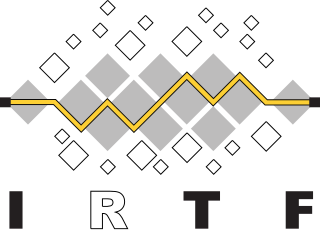Related Research Articles
In computer network engineering, an Internet Standard is a normative specification of a technology or methodology applicable to the Internet. Internet Standards are created and published by the Internet Engineering Task Force (IETF). They allow interoperation of hardware and software from different sources which allows internets to function. As the Internet became global, Internet Standards became the lingua franca of worldwide communications.

The Internet Engineering Task Force (IETF) is a standards organization for the Internet and is responsible for the technical standards that make up the Internet protocol suite (TCP/IP). It has no formal membership roster or requirements and all its participants are volunteers. Their work is usually funded by employers or other sponsors.
A Request for Comments (RFC) is a publication in a series from the principal technical development and standards-setting bodies for the Internet, most prominently the Internet Engineering Task Force (IETF). An RFC is authored by individuals or groups of engineers and computer scientists in the form of a memorandum describing methods, behaviors, research, or innovations applicable to the working of the Internet and Internet-connected systems. It is submitted either for peer review or to convey new concepts, information, or, occasionally, engineering humor.

Spamming is the use of messaging systems to send multiple unsolicited messages (spam) to large numbers of recipients for the purpose of commercial advertising, non-commercial proselytizing, or any prohibited purpose, or simply repeatedly sending the same message to the same user. While the most widely recognized form of spam is email spam, the term is applied to similar abuses in other media: instant messaging spam, Usenet newsgroup spam, Web search engine spam, spam in blogs, wiki spam, online classified ads spam, mobile phone messaging spam, Internet forum spam, junk fax transmissions, social spam, spam mobile apps, television advertising and file sharing spam. It is named after Spam, a luncheon meat, by way of a Monty Python sketch about a restaurant that has Spam in almost every dish in which Vikings annoyingly sing "Spam" repeatedly.
The Internet Architecture Board (IAB) is a committee of the Internet Engineering Task Force (IETF) and an advisory body of the Internet Society (ISOC). Its responsibilities include architectural oversight of IETF activities, Internet Standards Process oversight and appeal, and the appointment of the Request for Comments (RFC) Editor. The IAB is also responsible for the management of the IETF protocol parameter registries.

The Internet Research Task Force (IRTF) is an organization, overseen by the Internet Architecture Board, that focuses on longer-term research issues related to the Internet. A parallel organization, the Internet Engineering Task Force (IETF), focuses on the shorter term issues of engineering and standards making.
Sender Policy Framework (SPF) is an email authentication method which ensures the sending mail server is authorized to originate mail from the email sender's domain. This authentication only applies to the email sender listed in the "envelope from" field during the initial SMTP connection. If the email is bounced, a message is sent to this address, and for downstream transmission it typically appears in the "Return-Path" header. To authenticate the email address which is actually visible to recipients on the "From:" line, other technologies such as DMARC must be used. Forgery of this address is known as email spoofing, and is often used in phishing and email spam.

John R. Levine is an Internet author and consultant specializing in email infrastructure, spam filtering, and software patents.
An Internet Draft (I-D) is a document published by the Internet Engineering Task Force (IETF) containing preliminary technical specifications, results of networking-related research, or other technical information. Often, Internet Drafts are intended to be work-in-progress documents for work that is eventually to be published as a Request for Comments (RFC) and potentially leading to an Internet Standard.
MARID was an IETF working group in the applications area tasked to propose standards for email authentication in 2004. The name is an acronym of MTA Authorization Records In DNS.
DomainKeys Identified Mail (DKIM) is an email authentication method designed to detect forged sender addresses in email, a technique often used in phishing and email spam.
In networking, a black hole refers to a place in the network where incoming or outgoing traffic is silently discarded, without informing the source that the data did not reach its intended recipient.
Domain-based Message Authentication, Reporting and Conformance (DMARC) is an email authentication protocol. It is designed to give email domain owners the ability to protect their domain from unauthorized use, commonly known as email spoofing. The purpose and primary outcome of implementing DMARC is to protect a domain from being used in business email compromise attacks, phishing email, email scams and other cyber threat activities.
ASRG can stand for:

Barry Leiba is a computer scientist and software researcher. He retired from IBM's Thomas J. Watson Research Center in Hawthorne, New York in February 2009, and now works for FutureWei Technologies as a Director of Internet Standards. His work has focused for many years on electronic mail and anti-spam technology, on mobile computing and the Internet of things, and on Internet standards.

A feedback loop (FBL), sometimes called a complaint feedback loop, is an inter-organizational form of feedback by which a mailbox provider (MP) forwards the complaints originating from their users to the sender's organizations. MPs can receive users' complaints by placing report spam buttons on their webmail pages, or in their email client, or via help desks. The message sender's organization, often an email service provider, has to come to an agreement with each MP from which they want to collect users' complaints.

Mark James Handley is Professor of Networked Systems in the Department of Computer Science of University College London since 2003, where he leads the Networks Research Group.
Spam reporting, more properly called abuse reporting, is the action of designating electronic messages as abusive for reporting to an authority so that they can be dealt with. Reported messages can be email messages, blog comments, or any kind of spam.
HTTP/2 is a major revision of the HTTP network protocol used by the World Wide Web. It was derived from the earlier experimental SPDY protocol, originally developed by Google. HTTP/2 was developed by the HTTP Working Group of the Internet Engineering Task Force (IETF). HTTP/2 is the first new version of HTTP since HTTP/1.1, which was standardized in RFC 2068 in 1997. The Working Group presented HTTP/2 to the Internet Engineering Steering Group (IESG) for consideration as a Proposed Standard in December 2014, and IESG approved it to publish as Proposed Standard on February 17, 2015. The initial HTTP/2 specification was published as RFC 7540 on May 14, 2015.
Information-centric networking (ICN) is an approach to evolve the Internet infrastructure away from a host-centric paradigm, based on perpetual connectivity and the end-to-end principle, to a network architecture in which the focal point is identified information. Some of the application areas of ICN are in web applications, multimedia streaming, the Internet of Things, Wireless Sensor Networks and Vehicular networks and emerging applications such as social networks, Industrial IoTs.
References
- ↑ "Anti-Spam Research Group (ASRG)". Internet Research Task Force. 18 March 2013. Retrieved 18 March 2013.